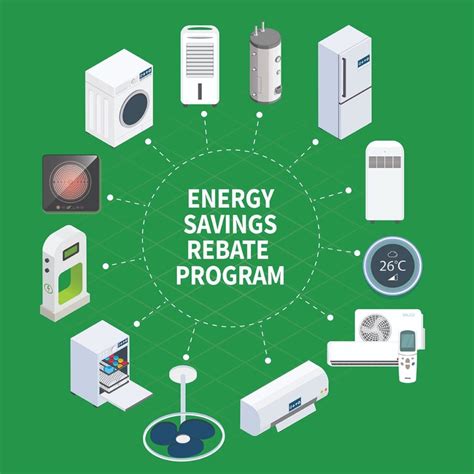Unlocking Savings: How the Federal Government Rebate Program Can Benefit You
In an age where financial prudence is crucial, the importance of making informed decisions regarding household expenses cannot be overstated. One such opportunity for savings comes from federal government rebate programs. These initiatives can significantly affect your financial landscape, offering reductions on various purchases—ranging from energy-efficient appliances to electric vehicles. In this article, we’ll explore how you can benefit from these programs, the types of rebates available, and how to navigate the application process.
Understanding Federal Rebate Programs
Federal rebate programs are financial incentives offered by the government to encourage certain behaviors, such as purchasing energy-efficient appliances or making home improvements that enhance energy efficiency. They are designed to reduce consumers’ out-of-pocket expenses while promoting broader goals such as sustainability and environmental responsibility.
Types of Rebates Available
Several types of federal government rebate programs cater to different sectors. Here are some of the most common:
1. Energy Efficiency Rebates
One of the most popular areas for rebates is energy efficiency. The Energy Star program, for instance, offers rebates on various appliances, including refrigerators, washing machines, and HVAC systems. These rebates often cover a percentage of the purchase price, making it easier to invest in energy-saving technology.
2. Electric Vehicle (EV) Rebates
The federal government is highly supportive of electric vehicles as a means to reduce carbon emissions. Through the Electric Vehicle Tax Credit, buyers may qualify for up to $7,500 in tax credits when purchasing eligible electric vehicles. This credit can be a game changer, making the initial investment in an EV more palatable.
3. Renewable Energy Rebates
For homeowners interested in renewable energy, the government provides rebates for installing solar panels and other renewable energy systems. The Solar Investment Tax Credit (ITC) is one of the most notable, allowing residents to deduct a significant percentage of their solar system costs from their federal taxes.
4. Home Improvement Rebates
Many local governments also offer rebate programs aimed at home improvements, particularly those that enhance energy efficiency, such as insulation or energy-efficient windows. These programs often overlap with federal initiatives, allowing homeowners to stack savings.
Eligibility Criteria
While many rebate programs can lead to significant savings, they often come with specific eligibility criteria. Generally, you should consider the following:
- Income Levels: Some programs are designed for low to moderate-income households, while others have no restrictions.
- Location: Availability of rebates can vary by state, so it’s essential to verify what programs are offered in your area.
- Product Type: Ensure that the product you are purchasing qualifies for the rebate. For example, Energy Star-certified appliances are typically eligible, while standard models are not.
Navigating the Application Process
Applying for a federal rebate may seem daunting, but it doesn’t have to be. Here’s a straightforward approach to help you through the process:
- Research Available Programs: Begin by checking out the USDA, Energy Star, and your local government’s website for available rebates.
- Gather Required Documents: Most programs will require proof of purchase, so keep receipts and any forming related to the purchase.
- Submit Your Application: Follow the guidelines provided by the agency, ensuring you fill out all necessary forms accurately.
- Track Your Application: After submission, keep track of your application status, and follow up if necessary.
Maximizing Your Savings
In addition to federal rebates, look into state-specific programs that can further enhance your savings. Many states have their programs that can be combined with federal initiatives to maximize overall benefits.
Furthermore, consider timing your purchases. Often, rebates can fluctuate based on the time of year, so keep an eye on seasonal sales to maximize the amount you save. Researching and planning can yield exponential savings.
Conclusion
Federal rebate programs present a fantastic opportunity for consumers to save money on essential purchases while contributing to environmental sustainability. By taking the time to understand the types of rebates available, eligibility criteria, and the application process, you can unlock significant savings that enhance your financial situation. Whether you’re upgrading to energy-efficient appliances or considering an electric vehicle, there are options out there tailored to your needs. Stay informed, stay motivated, and reap the rewards of your informed consumer choices.
FAQs
1. What types of purchases typically qualify for federal rebates?
Purchases that commonly qualify include energy-efficient appliances, electric vehicles, and renewable energy systems like solar panels.
2. How much can I save through federal rebate programs?
The amount varies widely depending on the program and your purchases. For example, the Electric Vehicle Tax Credit can provide savings of up to $7,500.
3. Do federal rebates apply to home improvements?
Yes, many programs offer rebates for home improvements, especially those that enhance energy efficiency, like new insulation or energy-efficient windows.
4. How do I check if I qualify for a rebate program?
You can typically find eligibility criteria on the specific program’s website or consult a local government resource for further guidance.
5. Are federal rebates the same across all states?
No, while some programs are federally mandated, many are state-specific, so availability may differ based on your location.
Download Federal Government Rebate Program
